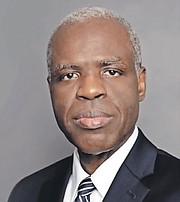• Economy poised to ‘resettle’ to traditional growth in 2024
• First-half foreign currency inflows not as strong as forecast
• External reserves healthy but set to close year below 2022
By NEIL HARTNELL
Tribune Business Editor
nhartnell@tribunemedia.net
The Central Bank’s governor yesterday again trimmed his 2023 economic growth forecast to “the 3 percent range” as he warned The Bahamas is poised to next year “resettle” back into low expansion rates.
John Rolle, addressing the regulator’s 2023 second quarter economic briefing, said The Bahamas must boost hotel room inventory to maintain tourism’s post-COVID recovery momentum (see other article on Page 1B) as he revealed that foreign currency inflows from the sector, foreign direct investment (FDI) and other private sectors were not as strong as anticipated during the first half.
Outflows on imported goods and services and overseas investments were stronger than inflows during the first six months of 2023, he disclosed, resulting in a much smaller expansion of The Bahamas’ external reserves when compared to the same period in 2022 and underscoring the need for this nation to retain more of its foreign currency earnings.
However, Mr Rolle also gave his second downward revision for The Bahamas’ 2023 economic growth prospects. “The Central Bank still projects some recovery-laced, above average real GDP growth in the 3 percent range for 2023. However, potential annual growth beyond 2023 is resettling closer to the two percent range,” he said.
During the Central Bank’s first quarter briefing, held at the beginning of May, the Governor predicted Bahamian gross domestic product (GDP) growth “will moderate closer to 4 percent” in 2023. This was a figure in line with International Monetary Fund (IMF) and World Bank forecasts, but slightly less than the 4-6 percent range he gave three months prior at end-January.
While 3 percent is still above The Bahamas’ long-term economic growth average, Mr Rolle yesterday affirmed that this nation is - as he previously forecast - on track to return to its traditional GDP growth rate of 2 percent or less unless it can rapidly and abruptly find extra stimulus from somewhere.
“Returning to the outlook, as stated earlier, it is expected that growth will moderate further in 2024 from the projected outcome for 2023, with subsiding inflation, chiefly as a result of the success in reducing inflation abroad. The economy’s expansion would also stimulate more employment, scope for increased labour force participation and improved conditions for bank lending,” he added.
While COVD-19 was no longer mentioned among the “downside risks” facing the Bahamian economy, Mr Rolle said rising interest rates in major overseas markets; the ongoing war in Ukraine; and continued oil price uncertainties all posed threats to this nation’s “positive” outlook - especially if they undermine the ability of persons to travel or increase transportation costs.
Indicating that the strength of tourism’s revival had failed to translate into anticipated foreign currency inflows, he added: “Turning to the foreign exchange indicators and external reserve trends, over the first six months of 2023 total inflows through the banking system - which capture impacts from tourism, foreign investment spending and other private sector activities - increased by 3.8 percent to $3.8bn.
“This compared to a recovery-related rebound of 50 percent in the same period of 2022 relative to 2021. Inflows, though, were expected to have been stronger, given the extent of strengthening in tourism indicators. This underscores the importance of boosting domestic retention from all subsectors in which growth is being noted.”
As for the opposite direction, the Central Bank governor added: “As expected, the growth in spending on imports of goods and services within the Bahamian economy and portfolio investments on the outflow side was stronger than trends on the inflow side, increasing by 11.1 percent in the first half of 2023.
“On a net basis, therefore, the private sector retained less foreign exchange than it took in during the first half, contributing to a smaller boost in the external reserves over this period. In particular, the net amount of foreign exchange that commercial banks sold to the Central Bank was one-third less than the first half in 2022.
“In addition, the volume of foreign currency denominated borrowing by the Government was sharply reduced in comparison to 2022, resulting in the public sector, on net, repaying some foreign currency debt and being a net purchaser of foreign exchange from the Central Bank.”
Explaining what this means for the external reserves, which underpin the one:one exchange rate peg with the US dollar, Mr Rolle said there was no cause for alarm. “The external reserves grew by just $117m in the first half of 2023 compared to a $788 million build-up in the same period in 2022,” he added. “As at the end of July, the external balances were approximately $2.7bn, not much changed from the end of June.
“These balances, however, remain healthy relative to the support that they provide for the Bahamian dollar fixed exchange rate. Over the remainder of 2023, the Central Bank will continue to plan for and to accommodate a net reduction in the external reserves, which would place the end of year balances below the closing levels of 2022.
“This remains consistent with an increased capacity, on net, for the Government to borrow in local currency, more room for growth in private sector credit, and other increased spending by residents from accumulated liquidity such as bank deposits.”





Comments
Use the comment form below to begin a discussion about this content.
Commenting has been disabled for this item.